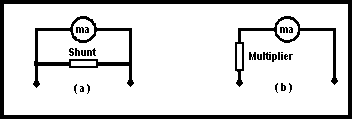
The basic instrument used for the measurement of voltage and current is the moving-coil meter. This comprises a coil of wire, generally wound on a rectangular former, which is mounted on pivots in the field of a permanent magnet (Fig 10.1). The coil develops a torque proportional to:

Fig 10.1. Construction of a moving-coil meter

A moving coil meter to indicate output on a variable power supply.
It is usual to 'damp' the coil system (ie prevent it swinging freely after a change of current), a common method being to wind the coil on an aluminium former, which then acts as a short-circuited, single-turn coil in which the eddy currents serve to oppose the movement. The degree of eddy current damping is also dependent on the external resistance across the terminals of the moving coil and is greatest when the resistance is low, It is a wise precaution to protect sensitive instruments not in use by short-circuiting the terminals.
The scale of the moving-coil instrument is linear; it can only be used on DC, but can be adapted to measure AC.

Fig 10.2. Extending range of an MC meter (a) to read higher current with parallel shunt, (b) to measure voltage with series resistor or multiplier
Milli-ammeters and micro-ammeters are commonly manufactured with full-scale deflections (FSDs) between about 25μA and l0mA. For higher current ranges, a shunt resistor is connected across the meter (see Fig 10.2(a)).
A milli-ammeter may be used to read DC voltages by connecting a resistor, termed a 'multiplier', in series with it (see Fig 10.2(b)).
The accuracy of a meter depends on many factors, eg size, quality, accuracy of shunt or multiplier resistor, the scale deflection (IC full-scale reading). Usually, the size of meter most likely to be used in amateur radio would be 60-75mm in diameter and the accuracy would be of the order of 3%.
If the resistance of a voltmeter is too low, it's likely that it will pass more current than the circuit whose supply voltage is being measured, the voltage measured at that point will therefore be lower than it actually is. Thus the sensitivity of a voltmeter is usually defined in 'ohms per volt' (Ω/V). For example if a voltmeter has a resistance of 20,000Ω (ie meter and multiplier) and a full-scale reading of l00V, its sensitivity is 20,000Ω/100V or 200Ω/V. This value is much too low for use on radio circuits. A satisfactory value is 20,000Ω / V which corresponds to a basic meter full-scale deflection of 50μA.
The modern trend is towards digital rather than the above described analogue instruments, on account of cost. As these are non-mechanical, they tend to be cheaper to produce and purchase than the analogue ones. They operate in a broadly similar way to their analogue equivalents, the main differences being the usually much better accuracy of the digital equivalent, relative cheapness, and high input impedance (1MΩ ). Analogue is to be preferred, when trying to assess a trend ie when trying to set a peak or a null in a circuit, which can be made difficult using a digital meter, in part due to their slowness of response.